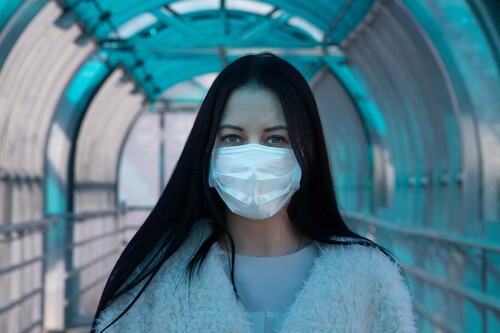INTERNET
COVID-19 Prevention
Workplace Sensing Tools That Help Keep Employees Safe
By Joe Dysart

workplaces to reassure employees that their health is protected from
COVID-19.
Many businesses determined to reassure employees that their workplaces are safe are turning to sensing devices to ferret out fevers, verify that all employees are wearing masks or even make video recordings of employees who are sneezing or coughing.
“Today, more than ever, managers are looking for innovative solutions to enhance their health screening processes,” said Renaud Mazarguil, president of gas analysis and safety for Honeywell.
As many managers know, surveillance temperature systems have been around for decades and are already commonly used at airports, train stations and other larger gathering places, but such devices are being given a run for their money by next-generation artificial intelligence (AI) sensing systems. Many of these software packages go beyond fever sensing to detect mask wearing, verify social distancing or pick out employees who are sneezing or coughing.
The beauty of many of these AI software systems is that they can be integrated into existing workplace security camera systems. Simply integrate the AI software into your existing camera system, and you’re good to go.
There is a rub, though. While provided with the best of intentions, employee surveillance systems can be controversial. Not everyone—including the Electronic Frontier Foundation—is doing cartwheels over the prospect of employers increasing surveillance of employees on the job—all approved by the federal government.
“The U.S. government is not known for its inclination to give back surveillance powers seized during extraordinary moments,” according to Matthew Guariglia, a policy analyst at the Electronic Frontier Foundation. “Once used in acute circumstances, a tool stays in the toolbox until it is taken away.”
Indeed, the Equal Employment Opportunity Commission (EEOC) was forced to scramble this spring to revise its workplace surveillance rules to benefit employers—just as the COVID-19 epidemic took hold in the United States (www.eeoc.gov/wysk/what-you-should-know-about-covid-19-and-ada-rehabilitation-act-and-other-eeo-laws).
The upshot of the EEOC’s move: Employers now have the right to take the temperatures of their workers whenever they want, and employers now have the right to withdraw a job offer if a candidate tests positive for COVID-19 during the qualification process.
The move was greeted by many employers with a sigh of relief—especially those who are being forced by their insurers to demonstrate that they are doing everything possible to protect the health of COVID-19-threatened employees.
Of course, having the right to monitor and actually winning employee buy-in of a new, well-intentioned health surveillance system is a tough needle to thread. Assuming you’re able to pull off that feat, below is a raft of sensing technology you can use to help minimize the worst nightmare of your employees: unmitigated spread of COVID-19 throughout your workplace.
Simple Gun Thermometers: Gun thermometers are commonly used in large public spaces like airports, where health officials need a quick, inexpensive way to detect fevers amid incoming and outgoing air passengers.
Dozens of makes of gun thermometers are available, and you can retrieve a full assessment of the top-rated models on shopping sites such as Amazon.com. Kuang-Chi Technology makes its own spin on the gun thermometer—the Thermal Scanner Helmet, N901 (www.kcwearable.com/enpc/2.html). It’s essentially the same tech as a gun thermometer embedded in a helmet that can be worn by a human monitor.
The primary advantage is that the thermometer is mobile—it can go anywhere the wearer is looking to monitor temperatures, including company entryways or a big company gathering in an off-site facility.
Unfortunately, the key drawback of the tech is that you need to dedicate an employee to do gun thermometer checks every morning or as often as makes you and your employees comfortable. That costs extra money, and it also creates an annoying barrier at the entry to your workplace. No one relishes the prospect of dealing with a fellow employee brandishing a forehead scanning device in front of their face each morning before they can get to their desk or workstation.
Surveillance Thermometers: Less intrusive by nature, surveillance thermometers can be positioned unobtrusively at key entry points to the workplace, silently scanning staff as they arrive. Standard-grade surveillance thermometers will probably work for most workplaces, but medical-grade thermometers (which are more precise and built to a higher standard) may be preferred by workplaces looking for a higher level of protection.
Most surveillance thermometers use thermal cameras built with infrared sensors that measure the heat emitted from the skin. Such sensing is not as good as a conventional thermometer, which measures a body’s internal temperature, but that has not stopped commercial users from relying on surveillance thermometers for years.
Popular surveillance thermometer makers include:
- FLIR Systems (www.flir.com): One of the most prolific makers of surveillance thermometers, FLIR is currently being forced to prioritize orders to hospitals and medical facilities, according to Frank Pennisi, the company’s president.
- Mobotix M16TB Thermal Weatherproof IP Camera (www.mobotix.com): This is another simple thermal camera imaging system that monitors for fevers and sends out an alert in the form of an audible alarm, network message or similar trigger when a fever is detected. All detections are recorded on an onboard micro SD card.
- Thermoteknix FevIR Scan 2 (www.thermoteknix.com): This system is designed for fever surveillance of large areas such as airports, train stations and large factories. Onscreen and audible alerts identify one or more individuals in a large crowd exhibiting fevers.
Similar surveillance thermometers are available from Seek Thermal (www.thermal.com) and 98.6 Labs (https://986labs.com).
AI Fever and Compliance Sensing Devices: AI-powered COVID-19 sensing devices tend to offer more monitoring than conventional temperature surveillance. Besides checking for fevers, many of these systems are also designed to discern if an employee is wearing a mask, engaging in safe social-distancing practices, or coughing or sneezing.
Most of the systems also do a great job of documenting health-threatening events by taking pictures of employees in question for later followup.
Here’s a representative sampling of AI-driven surveillance systems:
- OnDisplay SafeScan Kiosk (www.ondisplay.io): This is a relatively simple AI-powered system designed to do one thing well: take the temperature of each person who enters your workplace and identify who that person is by auto-referencing an employee database that includes pictures of each of your employees. Safe-Scan also records and stores the date, time, employee name and exact temperature of each assessment it makes.
- Honeywell ThermoRebellion (www.honeywell.com): Introduced in May 2020, ThermoRebellion uses AI to detect a fever by analyzing each individual pixel in a scene captured by its camera. The system also auto-logs the data it collects to help simplify and standardize any record keeping needed for insurer or government compliance requirements.
- Landing AI Social Distancing Camera (https://landing.ai): Landing AI’s software rings a buzzer any time people in your workplace congregate less than 6 ft. apart in a pre-designated area. Bonus: The software is designed to integrate into an existing security camera system.
- Kogniz Health Cam (www.kogniz.com): This system uses AI to track fevers, enforce social distancing and verify that employees are wearing masks and similar COVID-19 prevention gear. Health Cam also sends automatic alerts on this monitoring to appropriate management personnel—including when it detects too many people occupying a specific area.
 Draganfly Drone (https://draganfly.com): Capable of surveying large crowds from above, Draganfly is designed to pick out people who have fevers as well as those who are coughing or sneezing. Said Cameron Chell, the company’s CEO: “This coronavirus pandemic has opened up a new frontier for advanced drones.”
Draganfly Drone (https://draganfly.com): Capable of surveying large crowds from above, Draganfly is designed to pick out people who have fevers as well as those who are coughing or sneezing. Said Cameron Chell, the company’s CEO: “This coronavirus pandemic has opened up a new frontier for advanced drones.”
Joe Dysart is an internet speaker and business consultant based in Manhattan.
646-233-4089
joe@dysartnewsfeatures.com








